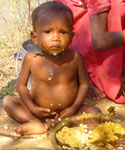A Unicef report says India has the highest number of malnourished children in the world: One in three of the world’s malnourished children is Indian. Of the world’s 146 million malnourished children, 57 million are in India; they are 47 per cent of under-fives in the country.
The corresponding figure for China is only 8 per cent but in Ethiopia (47 per cent) and Bangladesh (48 per cent) the scale of the problem is the same as India’s. Malnutrition occurs when there is insufficient nutrition intake — so necessary to maintain optimum bodily functions.
The poor are the worst hit, though it does surface, to a smaller extent, in developed countries too. The reason: inadequate diet on the one hand and inappropriate food intake on the other.
Besides poverty, absence of balanced diet is due to a dysfunctional public distribution system that, if run efficiently, could reach subsidised or even free nutritious food to the hungry.
There are other factors, too, that engender malnutrition, that have deep social reasons. Gender inequality makes women feed better and more to the male child at the cost of the girl child.
In middle-income groups, substituting breast milk with bottle feed deprives the infant of natural nutrients and immunity found in mother’s milk, and formula feeds are often over-diluted either due to ignorance or as a money-saving measure.
Poor hygiene is another factor. Also, since not all children are immunised against childhood diseases, they are vulnerable to weight loss and weakness. Illiteracy and ignorance are other major reasons why mothers — often very young and undernourished themselves — fail to take good care of infants.
The ICMR’s National Institute of Nutrition, Hyderabad, did a study that found 50 per cent of school-going children suffering from multiple micronutrient deficiency despite eating a ‘balanced’ diet that was high on quantity but low on protein, calories, vitamins and minerals, often falling far below the recommended daily allowance.
They appear to be ‘healthy’ when in fact they’re not. Merely talking about achieving millennium goals is not enough; efforts to improve nutrition intake should be stepped up via education, public awareness, good sanitation and an efficient public distribution system.

